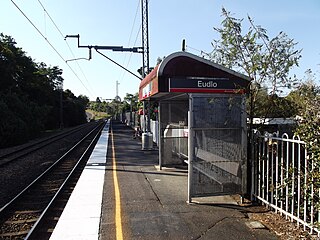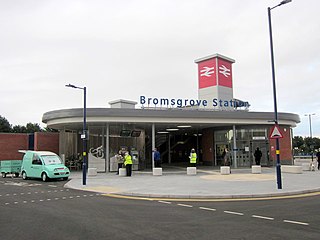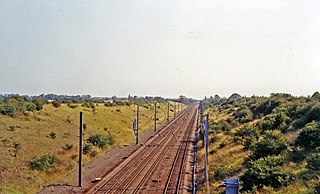The crash
At Lichfield Trent Valley station there were four tracks running through the station: two fast through lines in each direction with loops on each side for trains stopping at the station.
The crash occurred at 18:58, and involved the 14:50 fish train from Fleetwood to London Broad Street. This train consisted of seven four-wheel fish vans and a brake van hauled by a Stanier Class 5 4-6-0. It was travelling at around 35 mph when it passed into the station, and was scheduled to run through on the fast up line. However at the north end of the station, the points had become stuck in the position used by the preceding train – a Stafford to Nuneaton local passenger train, which had left the main line for the platform loop in order to stop at the station and was still waiting there for the goods train to pass. The goods train was diverted onto the platform loop where it collided with the rear end of the local passenger train. The passenger train consisted of four old wooden-bodied coaches; the force of the impact demolished the rear three coaches, and hurled the engine (LNWR Prince of Wales Class 4-6-0 number 25802) forwards 100 yards.
Casualties
20 passengers on the passenger train lost their lives – 13 in the collision and the remainder either in hospital or on the way there. Another 21 were injured, some seriously, including a porter on the platform who was injured by flying debris. The crew of the passenger train were unhurt, however the crew of the goods train suffered bruises and minor injuries, and the driver had to be treated for severe shock.

The Quintinshill rail disaster was a multi-train rail crash which occurred on 22 May 1915 outside the Quintinshill signal box near Gretna Green in Dumfriesshire, Scotland. It resulted in the deaths of over 200 people and remains the worst rail disaster in British history.

A passing loop or passing siding is a place on a single line railway or tramway, often located at or near a station, where trains or trams travelling in opposite directions can pass each other. Trains/trams going in the same direction can also overtake, provided that the signalling arrangement allows it. A passing loop is double-ended and connected to the main track at both ends, though a dead end siding known as a refuge siding, which is much less convenient, can be used. A similar arrangement is used on the gauntlet track of cable railways and funiculars, and in passing places on single-track roads.

The Abermule train collision was a head-on collision which occurred at Abermule, Montgomeryshire, Wales on Wednesday 26 January 1921, killing 17 people. The crash arose from misunderstandings between staff which effectively over-rode the safe operation of the Electric Train Tablet system protecting the single line. A train departed carrying the wrong tablet for the section it was entering and collided with a train coming the other way.

Preston railway station in Preston, Lancashire, England, is an interchange railway station on the West Coast Main Line, half-way between London Euston and Glasgow Central. It is served by Avanti West Coast, Northern Trains and TransPennine Express services, plus Caledonian Sleeper overnight services between London and Scotland. It is also served by the Calder Valley line to Leeds and York, and by branch lines to Blackpool, Ormskirk, and Colne.

Lichfield Trent Valley is a railway station on the outskirts of the city of Lichfield in Staffordshire, England. It is one of two stations in Lichfield, the other being Lichfield City in the city-centre. It is a split-level station, with low level platforms served by the Trent Valley section of the West Coast Main Line, and a single high level platform, which is the northern terminus of the Cross-City Line.

Eudlo railway station is located on the North Coast line in Queensland, Australia. It serves the town of Eudlo in the Sunshine Coast Region. It is one of few stations that can only fit 4 carriages onto the platform.

Copplestone railway station is on the Tarka Line serving the village of Copplestone in Devon, England. It is on the Tarka Line to Barnstaple, 14 miles 37 chains (23.3 km) from Exeter Central at milepost 185.75 from London Waterloo. The station and trains are operated by Great Western Railway.
The Connington South rail crash occurred on 5 March 1967 on the East Coast Main Line near the village of Conington, Huntingdonshire, England. Five passengers were killed and 18 were injured.

Bromsgrove railway station serves the town of Bromsgrove in Worcestershire, England. It is located at the foot of the two-mile Lickey Incline which ascends at a gradient of 1-in-37.7 towards Barnt Green on the line between Birmingham and Worcester. Bromsgrove is managed by West Midlands Railway. The current station opened on 12 July 2016, replacing an older station located slightly to the north.

The Abbots Ripton rail disaster occurred on 21 January 1876 at Abbots Ripton, then in the county of Huntingdonshire, England, on the Great Northern Railway main line, previously thought to be exemplary for railway safety. In the accident, the Special Scotch Express train from Edinburgh to London was involved in a collision, during a blizzard, with a coal train. An express travelling in the other direction then ran into the wreckage. The initial accident was caused by:

The Trent Valley line is a railway line between Rugby and Stafford in England, forming part of the West Coast Main Line. It is named after the River Trent which it follows. The line was built to provide a direct route from London to North West England and Scotland, and avoid the slower route between Rugby and Stafford via Birmingham.
There have been a number of train accidents on the railway network of Victoria, Australia. Some of these are listed below.
The railways of New South Wales, Australia have had many incidents and accidents since their formation in 1831. There are close to 1000 names associated with rail-related deaths in NSW on the walls of the Australian Railway Monument in Werris Creek. Those killed were all employees of various NSW railways. The details below include deaths of employees and the general public.
The Coton Hill rail crash was a train crash which occurred on 11 January 1965, at Coton Hill, near Shrewsbury in Shropshire, England.
The Tamworth rail crash was an accident that happened at Tamworth railway station in Staffordshire, England, on 14 September 1870. It was caused when a signalman's error accidentally diverted the Irish Mail express onto a dead end siding, where part of the train crashed through the buffers and into the River Anker. Three people were killed, and thirteen injured.
On 3 February 2003, a Comeng electric multiple unit train rolled away from Broadmeadows station in Melbourne, Australia, before it ran for nearly 17 kilometres (11 mi) out of control without a driver and eventually crashed into another train about to depart Spencer Street station. Train controllers attempted several times to stop or redirect the train, but were limited in their ability to intervene, instead being forced to alter the route of other trains to avert a more serious collision. Eleven people on board the stationary train were injured; authorities did not know until after the crash if any passengers were on board the runaway. An investigation identified driver error as the cause of the accident, but the runaway event prompted significant debate about the role of government authorities and private operators in ensuring safety and reliability on the Melbourne rail network.
This page is based on this
Wikipedia article Text is available under the
CC BY-SA 4.0 license; additional terms may apply.
Images, videos and audio are available under their respective licenses.









